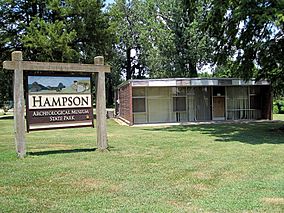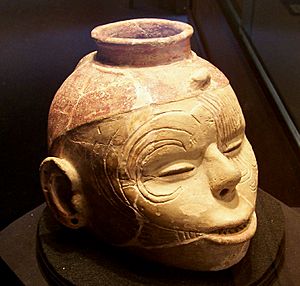Hampson Archeological Museum State Park facts for kids
Quick facts for kids Hampson Archeological Museum State Park |
|
|---|---|

Hampson Museum, 2010
|
|
| Location | Wilson, Mississippi, Arkansas Delta, Arkansas, United States |
| Area | 5 acres (2.0 ha) |
| Established | 1961 |
| Named for | James K. Hampson |
| Governing body | Arkansas Department of Parks and Tourism |
| Website | [1] |
Hampson Archeological Museum State Park is a special place in Mississippi County, Arkansas. It's a 5-acre state park that holds amazing secrets from the past! The museum here shows off a huge collection of archeological artifacts. These items come from the Nodena site, which was once a busy Native American village. This village was located right on the Mississippi River between the years 1400 and 1650.
A local landowner and archaeologist named James K. Hampson started digging at the Nodena site in the 1920s. He found many incredible things! A museum was built in 1946 to keep these treasures safe. The state of Arkansas officially took over the collection from the Hampson family on March 30, 1957. The park first opened in 1961 as Hampson Museum State Park and later got its current name.
The museum is named after James K. Hampson, who was a local landowner and an expert in finding old things.
Contents
Discover the Ancient Nodena Village
About 5 miles (8 km) east of Wilson, you'll find the Nodena site. This is where archaeologists discovered many artifacts from an ancient village. The people who lived here are called the Nodena people. They lived in this area between 1400 and 1650 CE.
The Hampson Museum State Park has a fantastic collection of these artifacts. The museum helps us understand the culture of the Nodena people. They lived in a 15-acre village that was surrounded by a strong wooden fence, called a palisade. Their village was on a horseshoe-shaped bend of the Mississippi River.
The museum's exhibits teach us about many parts of their lives. You can learn about how they grew crops, how they hunted, and what their social life was like. The exhibits also cover their religion and how their village was run.
The Nodena site is so important that it was named a National Historic Landmark in 1964. It was also added to the National Register of Historic Places in 1966.
Another ancient village, similar to Nodena, is the Parkin Indian Mound. It's located about 30 miles (50 km) southwest of Wilson, in Parkin.
Meet James K. Hampson, the Archaeologist
The museum is named after James K. Hampson (1877-1956). He owned the land where the Nodena site was found. He was also the archaeologist who worked hard to dig up and protect the amazing artifacts from the Nodena site.
In 1900, James K. Hampson also recorded another incredible discovery. He found the skeleton of a prehistoric mastodon! This huge animal's remains were found about 2 miles (3.2 km) south of the Nodena site.
Finding a Giant Mastodon Skeleton
Mastodons were ancient animals that looked a lot like modern elephants. They are now extinct, meaning they no longer exist. These giant creatures lived in North America for almost 4 million years. They finally disappeared about 10,000 years ago.
In 1900, James K. Hampson documented the discovery of a mastodon's skeletal remains. They were found on Island No. 35 in the Mississippi River. This spot was 2 miles (3.2 km) south of the Nodena site. It was also 23 miles (37 km) south of Blytheville, Arkansas.
Sadly, the site where the mastodon was found was reported as destroyed in 1957. However, some fossilized bones from this discovery are on display at the Hampson Museum State Park.
The museum moved into a new building on the Wilson city square in 2018. It is now open for visitors. You can call 870-655-8622 for more information about visiting.
See also




